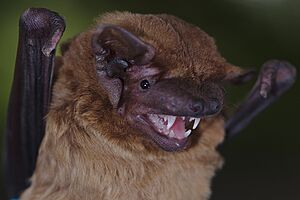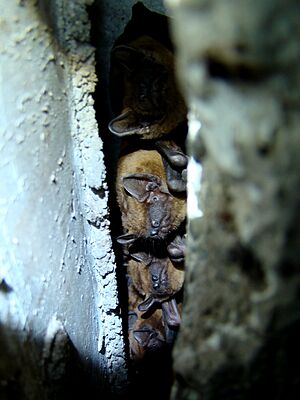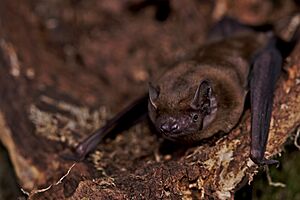Common noctule facts for kids
Quick facts for kids Common noctule |
|
|---|---|
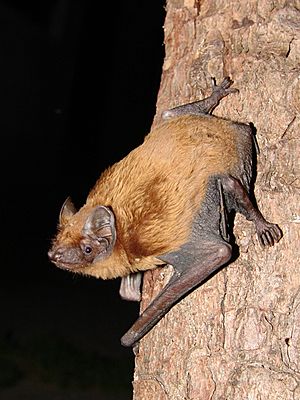 |
|
| Conservation status | |
| Scientific classification | |
| Genus: |
Nyctalus
|
| Species: |
noctula
|
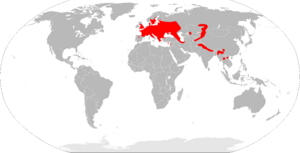 |
|
| Distribution of the common noctule | |
The common noctule (Nyctalus noctula) is a type of bat that eats insects. You can find these bats all over Europe, Asia, and North Africa. They are known for their fast flight and interesting migration habits.
Contents
What Does a Common Noctule Look Like?
The common noctule has short fur. It is dark brown after the bats shed their old fur, which happens in June for males and July or August for females. Later, their fur turns a reddish-brown color before winter arrives.
When a common noctule is awake, its body temperature is about 36.5 degrees Celsius (97.7 degrees Fahrenheit). However, when they are resting, their body temperature drops a lot. Adult common noctules weigh about 25 to 30 grams (0.9 to 1.1 ounces). Their wings can spread out to be 37 to 40 centimeters (14.5 to 15.7 inches) wide.
These bats fly very fast when they are looking for food, usually between 20 to 40 kilometers per hour (12 to 25 miles per hour). Sometimes, they can even reach speeds of 60 kilometers per hour (37 miles per hour)!
Because insects are not always available, common noctules only hunt for about an hour each day, around sunrise and sunset. This means they can go without food for up to 23 hours a day.
Where Do Common Noctules Live?
Common noctules live in many parts of the world. You can find them across most of Europe, central Russia, and over the Ural Mountains. They also live in places like Turkey, the Near East, and parts of Siberia. Further east, they are found in the Himalayas, China, Malaysia, Taiwan, and Japan. In Bulgaria, they are common and prefer to live in forests with trees that lose their leaves.
Common Noctule Life Cycle
Reproduction and Migration
Common noctules are migratory bats, which means they travel long distances. Interestingly, mostly the females migrate, while the males tend to stay in one area.
Mating season happens in late summer in the areas where they spend the winter. Female bats store the male's sperm inside their bodies during hibernation. Fertilization, when the egg and sperm combine, happens in the spring.
In late April, when they are early in their pregnancy, females fly north. Some travel as far as the Baltic region. They go back to the places where they were born to have their babies. After being pregnant for six to eight weeks, they give birth. Each female usually has one or two young bats each year.
When a baby bat is born, it weighs about one-third of its mother's weight. The young bats drink their mother's milk for three to four weeks. After this time, they leave the roost almost fully grown. This means the mother bat raises her offspring to full size just by feeding them milk.
Male common noctules do not migrate. Instead, they spread out along the routes the females use for migration. This gives them a better chance of finding the first females returning to the wintering areas. During the summer, male noctules usually live alone or in small groups with other males.
In Europe, most young bats are raised in the northern parts of their habitat, generally north of 48–49 degrees North latitude. However, some smaller breeding areas are also found in Slovakia, Hungary, Bulgaria, Slovenia, the Iberian Peninsula, and Italy.
Hibernation
Common noctule bats hibernate during the winter. This means they go into a deep sleep to save energy when food is scarce. Sometimes, many bats gather together in hibernation colonies, with up to 1,000 bats in one place.
In late summer, adult female bats fly back south to their wintering areas. The young bats follow them later. They hibernate in warmer places to avoid too many days below 0 degrees Celsius (32 degrees Fahrenheit) in winter.
Common noctules usually start hibernating in November, but this depends on how cold it is outside. They hibernate in large groups with both males and females together. Tree holes are not warm enough for them in winter. So, they use caves, church steeples, or even apartment buildings in Eastern Europe. In cities there, they are often the most common bat species to hibernate in buildings. Sometimes, their summer homes and winter hibernation spots are hundreds of kilometers apart.
What Do Common Noctules Eat?
When common noctules hunt, they often start flying at early dusk, even before most other European bats. They fly high above forests, which is their favorite place to live. They can reach speeds of up to 50 kilometers per hour (31 miles per hour) while hunting. Common noctule bats mainly eat beetles, moths, and winged ants.
How Do Common Noctules Use Echolocation?
Common noctules use echolocation to find their way around and hunt in the dark. Echolocation is like using sound waves to "see." They make sounds and listen for the echoes that bounce back. This helps them figure out where objects and prey are.
They use two main types of calls for echolocation. The first call has frequencies between 26 and 47 kilohertz (kHz), with the strongest sound at 27 kHz. This call lasts about 11.5 milliseconds. The second call has frequencies between 22 and 33 kHz, with the strongest sound at 22 kHz. This call lasts about 13.8 milliseconds.
Common Noctule Habitat
The common noctule prefers small to medium-sized woodlands. However, they will fly up to 20 kilometers (12 miles) away from the woods at night to find food. During the day, they usually rest in holes in trees or in special bat boxes attached to tree trunks.
While they generally live in wooded areas, some groups of common noctules also live successfully in cities. Examples include Hamburg, Vienna, Brno, and other cities in central Europe.
Protecting Common Noctules
The common noctule is a protected species in the European Union under the Habitats Directive. It is also listed in the Berne Convention, which aims to protect wildlife. The UNEP-EUROBATS convention also specifically works to protect this species. Many countries also have their own laws to protect common noctules and their homes.
To show how important it is to protect this bat across Europe, the common noctule was chosen as the "Bat species of the Year" in 2016 and 2017 by BatLife Europe, a large European organization that works to protect bats.



